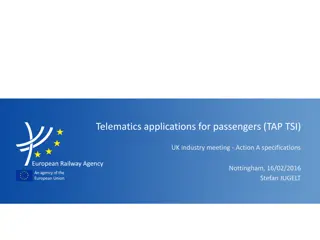Comprehensive Overview of Rail Transport in Tourism
This comprehensive overview delves into various aspects of rail transport in tourism. It discusses rail traffic types, high-speed rail, rapid transit, light rail, institutional frameworks, passenger traffic demand worldwide, and global track infrastructure supply. The content covers essential information on railway networks, governance structures, and legal and regulatory frameworks, providing valuable insights into the role of rail transportation in the tourism industry.
Download Presentation

Please find below an Image/Link to download the presentation.
The content on the website is provided AS IS for your information and personal use only. It may not be sold, licensed, or shared on other websites without obtaining consent from the author.If you encounter any issues during the download, it is possible that the publisher has removed the file from their server.
You are allowed to download the files provided on this website for personal or commercial use, subject to the condition that they are used lawfully. All files are the property of their respective owners.
The content on the website is provided AS IS for your information and personal use only. It may not be sold, licensed, or shared on other websites without obtaining consent from the author.
E N D
Presentation Transcript
Introduction to Tourism Transport Tourism Transport Introduction to SVEN GROSS LOUISA KLEMMER
Chapter 6 Rail
Rail Rail traffic More rail Railway transportation Rail in amusement sector Inter-urban rail services Rapid transit Other rail traffic Mountain railways Adhesion railways Funiculars Cog railways Land-based cableways Aerial cableways Specific
Rail train: one or more railway vehicles hauled by one or more locomotives or railcars, or one railcar travelling alone, running under a given number or specific designation from an initial fixed point to a terminal fixed point. A light engine, i.e. a locomotive travelling on its own, is not considered to be a train (Glossary of Transport Statistics, 2009) high-speed rail: designed to travel at a speed between 250 and 300 km/h on special lines, or around 200 km/h on existing older but upgraded lines (UIC, 2010a) rapid transit: an electric rail line mainly for urban transport with the capacity for heavy volumes of traffic involving very frequent train movements. Metro lines are also characterized by closely spaced stations, normally with around 1000 m between the stations (Glossary of Transport Statistics, 2009) light rail: a rail line mainly for urban transport of passengers often electrified. Stations/halts are generally less than 1200 m apart (Glossary of Transport Statistics, 2009)
Institutional Framework no internationally uniform legal or regulatory framework regarding rail infrastructure or operations rail networks: governed and regulated at many levels national laws regional agreements international agreements railroad governance of the USA, Canada and Mexico: several institutions and organizations involved federal departments and agencies provinces or states railway companies labour unions
Demand World passenger traffic 2010 - pkm (billions) 2765 2079 415 139 9 62 Europe non-CIS Russia USA* and Canada Asia and Oceania Africa Total * USA only 2009 data 2010 available in September 2011 Source: UIC, 2011
Supply Worldwide track infrastructure (in km) Source: Adapted from UIC, 2009; VDB, 2011, p. 8; VDB, 2012, p. 8; EUROSTAT, 2013























